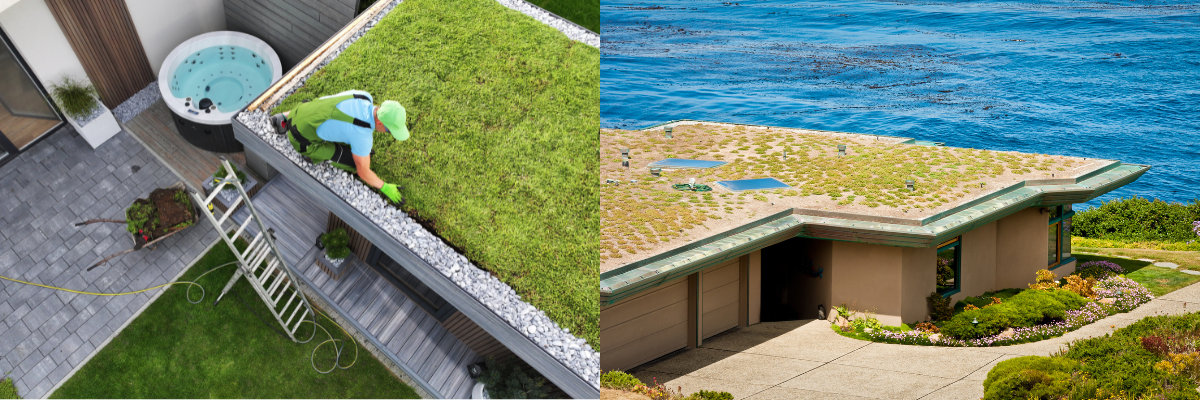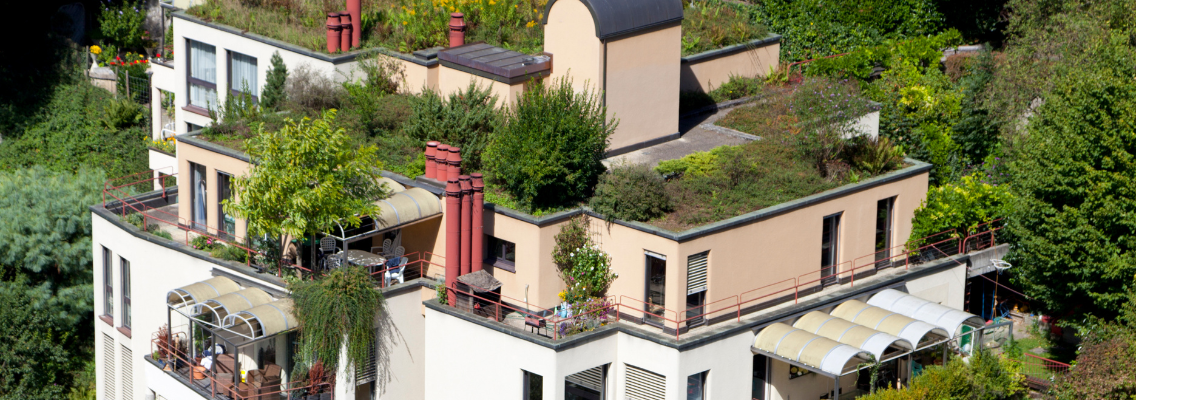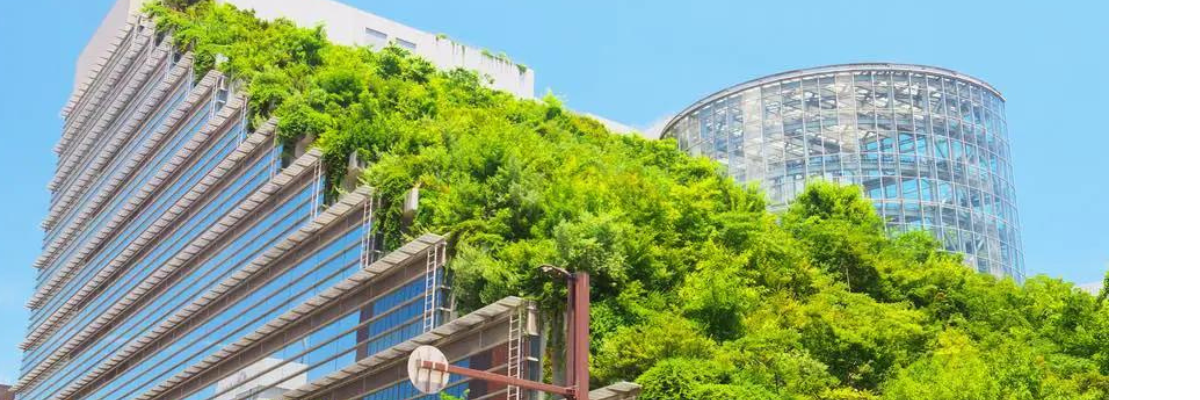
The world we live in is increasingly embracing more ecological and sustainable initiatives. Green roofs are one of them, and this trend has become very popular due to the benefits it provides and the aesthetics it offers. Furthermore, it represents a step forward for the atmosphere of cities and may be a way to combat the current climate crisis. Green roofs can mitigate the urban heat island effect and represent an important measure for building a city with regulated temperature. An interesting and easy-to-install option. We’ll tell you all about it. Keep reading!
Índice de contenidos
What are green roofs?
A green roof, also known as a living roof or vegetated roof, is the roof of a building that is covered with vegetation, either in soil or an appropriate growing medium. It can be planted with grass, trees, or shrubs. Depending on the type of green roof installed, the plants that inhabit it may be modular or have draining layers.
All green roofs have common features. The first is the waterproofing of the building or house on which they are installed. The second is that they naturally repel roots to avoid structural problems.
What is the purpose of green roofs?
In densely populated areas, more buildings are being constructed, which is why these roofs benefit the entire community. Why? Their goal is to counteract the urban heat island effect by reducing ambient temperatures by 0.3 to 3°C. Additionally, they contribute oxygen to the environment and improve the climate that has deteriorated over the years due to pollution and contamination.
These roofs also serve to protect waterproofing, insulate buildings, and filter out dust and dirt particles, preventing harmful substances from reaching us. In other words, they reduce the carbon footprint. It’s important to note that they enhance the appearance of buildings and create urban biological corridors.
Advantages of green roofs

Many are the advantages of green roofs. Sustainable constructions take the idea of a green roof and adapt it to new buildings. There are already countries like France and Germany that have passed laws requiring new constructions to incorporate green or solar coverings. We’ll show you the benefits of this type of roofing.
- Improved Energy Efficiency
Vegetation on roofs acts as a natural thermal insulator, stabilizing the internal temperature of buildings. This reduces the reliance on heating systems, which in turn decreases energy consumption and operating costs.
- Reduction of the Urban Heat Island Effect
Thanks to the cooling effect of plants, green roofs help mitigate the urban heat island effect in cities.
- More Efficient Solar Panels
Green roofs significantly reduce the roof’s temperature. Therefore, they ensure that the roof stays cooler, resulting in much higher solar panel efficiency.
- Rainwater Reservoir
Green roofs serve as reservoirs for rainwater, allowing plants to store rainwater. What does this mean? These roofs help reduce the load on sewers and also reduce the risk of flooding during periods of heavy rainfall through filtration.
- Habitat for Biodiversity
These roofs provide vital spaces for a variety of plants and animals, enriching urban biodiversity. They are especially beneficial for bees and other pollinators, playing a crucial role in maintaining healthy ecosystems.
- Acoustic Insulation
Another benefit that these types of roofs can provide is the acoustic insulation they offer. Plants act as barriers to control external noise from the building or house they are placed on. You will achieve a cooler and quieter environment.
- A Roof More Resistant to Fire
As plants naturally absorb moisture, they make the roof of the house a bit more fire-resistant. High temperatures lead to a higher risk of fire, and it’s always good to have different barriers and protections.
- Reduction of Heat
Temperatures are increasingly higher in the summer, and that’s why any element that helps lower them a bit is a good idea. One of the great advantages of these types of roofs is that they make the climate a bit cooler and more pleasant. Air conditioning won’t be as necessary in the summer season.
- Much Purer Air
Planting vegetation helps filter air particles, transforming CO2 from the environment into oxygen. As mentioned earlier, this system promotes much purer air around us.
- Improved Aesthetics and Psychological Well-being
Transforming the concrete deserts of cities into spaces filled with natural life. This green environment not only enhances the aesthetics of the building but also improves the psychological well-being of residents and urban workers.
Types of Green Roofs
For different types of housing, there are different types of green roofs that you can choose based on the roof you have in your home or workplace. Green roofs require regular maintenance to avoid structural problems and keep the vegetation in good condition. This includes removing dead plants, fertilizing, and watering. There are many types of green roofs, depending on the structure, climate, and roof usage, one will be installed over another. The most common types are:
Intensive green roofs
Intensive green roofs are accessible garden roofs. They are like rooftop gardens, often with a wide cover, and require more thorough maintenance than other options. Also, they need slightly higher structural loads and substrate thickness to maintain all plants perfectly.
These green roofs can support a total of 730 kilograms of plants per square meter. The average installation cost is around 150 euros per square meter.
Extensive green roofs
Extensive green roofs are one of the most commonly used options due to their price and ease of installation. They are recommended for commercial and residential buildings. They are installed on more complicated roofs because their structure is very lightweight. They are suitable for high-rise buildings. Unlike intensive green roofs, these gardens are more “wild” and cannot be walked or visited by the public. They support smaller plants, such as grass and small shrubs. They only require a reduced substrate to remain beautiful.
Up to 120 kilograms of greenery per square meter can be installed, with half the cost of an intensive roof (75 euros per square meter).
Semi-Intensive green roofs
If we combine intensive and extensive, this type of roof emerges. They have a depth of between 120 and 250 mm and require a bit more care than extensive ones. While in the extensive roof, the composition of the plants and their growth follows their own natural process, the semi-extensive roof allows you to customize the plantation to your liking. The semi-extensive planting consists of some succulents from the extensive type families, mixed with small shrubs and aromatic plants.
They are usually placed on thinner roofs and often have an area that can be accessed for use as a garden.
Biodiverse green roofs
Biodiverse green roofs are specially designed to attract and maintain certain species of plants, insects, and birds, recreating an environment similar to what existed before the building was constructed. This type of roof includes areas of sparse vegetation, called brown roofs, which focus on supporting specific groups of flora and fauna.
What is needed and how to install a green roof

Before installing a green roof, it is important to ensure that the building’s structure is designed and constructed properly to support the additional weight of the green roof. This may include reinforcing the structure with additional beams and columns or using more resilient building materials.
Installing a green roof is not a simple task, but by following the correct steps, there should be no issues.
Here is what is needed for its installation:
- Waterproofing: This is a crucial step to prevent issues with moisture or water infiltration.
- Waterproof Membrane: These sheets are used to improve thermal insulation and can be made of materials like polystyrene. They should be well supported.
- Drainage Layer: A filtering layer is necessary to prevent water from causing structural problems in the building.
- Root Barrier: As mentioned, the goal of this type of roof is to prevent roots from becoming a problem for any building, regardless of its size.
- Vegetative Soil Layer: The substrate is one of the most important steps. It should not fall between the sheets already in place. It’s essential to ensure the correct depth and proper moisture.
- Seeds: In the final step, seeds are planted to create a garden with the variety of plants chosen beforehand.
Installation: The idea is to create a sandwich of materials, much like what exists in natural soil. Here are the steps to install a green roof of approximately 10 square meters:
Load Conditions: First and foremost, ensure that the load conditions required for the roof or terrace are met. A green roof weighs between 60 and 150 kg/m2. To determine if your roof can support it, consulting an architect is the only option. They will also consider load situations due to water or snow.
Clean the Roof: Ensure that the entire surface is clean, free of dust or debris.
Waterproofing: This is a fundamental component for the success of green roofs. It will prevent leaks within the system. A good option for waterproofing that lasts more than fifteen years is to install a new waterproofing membrane to ensure no leaks occur. It can be asphalt, rubber, or PVC.
Drainage: The green roof must be able to remove water to prevent it from accumulating. If you see that water is not flowing, elevate the surface with small stones. The passage to the gutters must always be clear. To install the drainage layer, the filter should be on top, and the sheets should be well supported and stretched. Seal the edges.
Substrate: With the substrate moistened, spread it evenly across the surface, making sure it is well extended. Be careful not to let it seep through the sides of the drainage layer. Before proceeding to the next step, ensure that the substrate has the recommended depth. Depending on the types of plants that will be used, the depth will range from about 10 to 20 cm. Garden soil is not suitable because it is too heavy. It is recommended to use tezontle, comprising 80%, mixed with organic matter, 20%.
Sowing: It is recommended to lay the vegetative turf between two people, always with the roll facing outward. If you prefer not to use vegetative turf, you can directly sow the seeds.
Irrigation: To encourage the plants to develop their roots in the substrate, regular watering of the roof is necessary for the first three weeks.
Cost of a green roof
The cost of a green roof can range from 85 to 450 euros per square meter, depending on the type you choose. Artificial ones are cheaper, starting at 85€ and going up to 260€ for a more aesthetic option. Natural ones are more expensive, around 450€, because they require irrigation and drainage systems. There is also an intermediate option, preserved green roofs, which combine elements of both artificial and natural green roofs and cost between 250 and 350€ per square meter.
Lifespan of a Green Roof
The lifespan of a green roof depends on several factors, including the climate. They typically have a lifespan of 20 to 50 years when proper maintenance is followed. Additionally, some green roof materials, such as artificial grass, may have a longer lifespan than natural vegetation.
Green roofs are here to stay. With the benefits they can bring to your home, they are a sustainable and aesthetically pleasing choice. Now you know how to install them and the different types you can choose depending on your current and future needs.